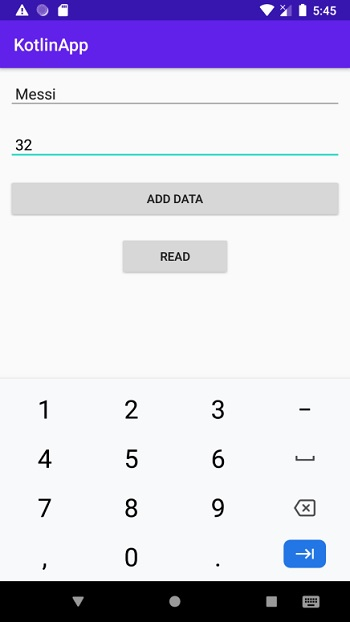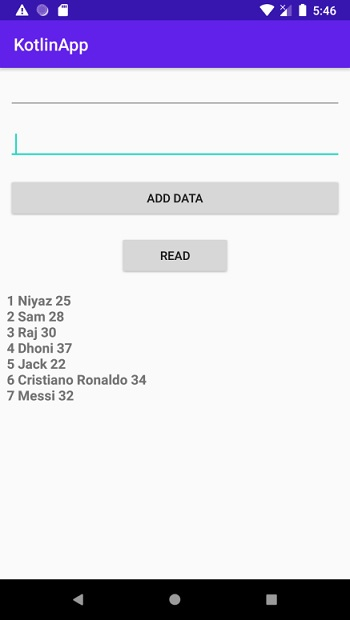
 Data Structure
Data Structure Networking
Networking RDBMS
RDBMS Operating System
Operating System Java
Java MS Excel
MS Excel iOS
iOS HTML
HTML CSS
CSS Android
Android Python
Python C Programming
C Programming C++
C++ C#
C# MongoDB
MongoDB MySQL
MySQL Javascript
Javascript PHP
PHP
- Selected Reading
- UPSC IAS Exams Notes
- Developer's Best Practices
- Questions and Answers
- Effective Resume Writing
- HR Interview Questions
- Computer Glossary
- Who is Who
How to use a simple SQLite database in Kotlin android?
This example demonstrates how to use a simple SQLite database in Kotlin android.
Step 1 − Create a new project in Android Studio, go to File ? New Project and fill all required details to create a new project.
Step 2 − Add the following code to res/layout/activity_main.xml.
<?xml version="1.0" encoding="utf-8"?> <LinearLayout xmlns:android="http://schemas.android.com/apk/res/android" xmlns:app="http://schemas.android.com/apk/res-auto" xmlns:tools="http://schemas.android.com/tools" android:layout_width="match_parent" android:layout_height="match_parent" android:orientation="vertical" tools:context=".MainActivity"> <LinearLayout android:layout_width="match_parent" android:layout_height="wrap_content" android:orientation="vertical"> <EditText android:id="@+id/editTextName" android:layout_width="match_parent" android:layout_height="wrap_content" android:layout_margin="10dp" android:padding="8dp" /> <EditText android:id="@+id/editTextAge" android:layout_width="match_parent" android:layout_height="wrap_content" android:layout_margin="10dp" android:autofillHints="Age" android:inputType="number" android:padding="8dp" android:textColor="@android:color/background_dark" /> <Button android:id="@+id/btnInsert" android:layout_width="match_parent" android:layout_height="wrap_content" android:layout_margin="10dp" android:padding="8dp" android:text="Add data" /> </LinearLayout> <LinearLayout android:layout_width="match_parent" android:layout_height="wrap_content" android:gravity="center" android:orientation="horizontal" android:weightSum="3"> <Button android:id="@+id/btnRead" android:layout_width="0dp" android:layout_height="wrap_content" android:layout_margin="10dp" android:layout_weight="1" android:padding="8dp" android:text="Read" /> </LinearLayout> <ScrollView android:layout_width="match_parent" android:layout_height="match_parent> <TextView android:id="@+id/tvResult" android:layout_width="match_parent" android:layout_height="wrap_content" android:padding="8dp" android:textSize="16sp" android:textStyle="bold" /> </ScrollView> </LinearLayout>
Step 3 − Add the following code to src/MainActivity.kt
package app.com.q10
import androidx.appcompat.app.AppCompatActivity
import android.os.Bundle
import android.widget.Toast
import kotlinx.android.synthetic.main.activity_main.*
class MainActivity : AppCompatActivity() {
override fun onCreate(savedInstanceState: Bundle?) {
super.onCreate(savedInstanceState)
setContentView(R.layout.activity_main)
title = "KotlinApp"
val context = this
val db = DataBaseHandler(context)
btnInsert.setOnClickListener {
if (editTextName.text.toString().isNotEmpty() &&
editTextAge.text.toString().isNotEmpty()
) {
val user = User(editTextName.text.toString(), editTextAge.text.toString().toInt())
db.insertData(user)
clearField()
}
else {
Toast.makeText(context, "Please Fill All Data's", Toast.LENGTH_SHORT).show()
}
}
btnRead.setOnClickListener {
val data = db.readData()
tvResult.text = ""
for (i in 0 until data.size) {
tvResult.append(
data[i].id.toString() + " " + data[i].name + " " + data[i].age + "
"
)
}
}
}
private fun clearField() {
editTextName.text.clear()
editTextAge.text.clear()
}
}
Step 4 − Add the following code to src/DataBaseHelper.kt
import android.content.ContentValues
import android.content.Context
import android.database.sqlite.SQLiteDatabase
import android.database.sqlite.SQLiteOpenHelper
import android.widget.Toast
val DATABASENAME = "MY DATABASE"
val TABLENAME = "Users"
val COL_NAME = "name"
val COL_AGE = "age"
val COL_ID = "id"
class DataBaseHandler(var context: Context) : SQLiteOpenHelper(context, DATABASENAME, null,
1) {
override fun onCreate(db: SQLiteDatabase?) {
val createTable = "CREATE TABLE " + TABLENAME + " (" + COL_ID + " INTEGER PRIMARY KEY AUTOINCREMENT," + COL_NAME + " VARCHAR(256)," + COL_AGE + " INTEGER)"
db?.execSQL(createTable)
}
override fun onUpgrade(db: SQLiteDatabase?, oldVersion: Int, newVersion: Int) {
//onCreate(db);
}
fun insertData(user: User) {
val database = this.writableDatabase
val contentValues = ContentValues()
contentValues.put(COL_NAME, user.name)
contentValues.put(COL_AGE, user.age)
val result = database.insert(TABLENAME, null, contentValues)
if (result == (0).toLong()) {
Toast.makeText(context, "Failed", Toast.LENGTH_SHORT).show()
}
else {
Toast.makeText(context, "Success", Toast.LENGTH_SHORT).show()
}
}
fun readData(): MutableList<User> {
val list: MutableList<User> = ArrayList()
val db = this.readableDatabase
val query = "Select * from $TABLENAME"
val result = db.rawQuery(query, null)
if (result.moveToFirst()) {
do {
val user = User()
user.id = result.getString(result.getColumnIndex(COL_ID)).toInt()
user.name = result.getString(result.getColumnIndex(COL_NAME))
user.age = result.getString(result.getColumnIndex(COL_AGE)).toInt()
list.add(user)
}
while (result.moveToNext())
}
return list
}
}
Step 5 − Add the following code to androidManifest.xml
<?xml version="1.0" encoding="utf-8"?> <manifest xmlns:android="http://schemas.android.com/apk/res/android" package="app.com.kotlipapp"> <application android:allowBackup="true" android:icon="@mipmap/ic_launcher" android:label="@string/app_name" android:roundIcon="@mipmap/ic_launcher_round" android:supportsRtl="true" android:theme="@style/AppTheme"> <activity android:name=".MainActivity"> <intent-filter> <action android:name="android.intent.action.MAIN" /> <category android:name="android.intent.category.LAUNCHER" /> </intent-filter> </activity> </application> </manifest>
Let's try to run your application. I assume you have connected your actual Android Mobile device with your computer. To run the app from android studio, open one of your project's activity files and click the Run ![]() icon from the toolbar. Select your mobile device as an option and then check your mobile device which will display your default screen –
icon from the toolbar. Select your mobile device as an option and then check your mobile device which will display your default screen –


Click here to download the project code.

